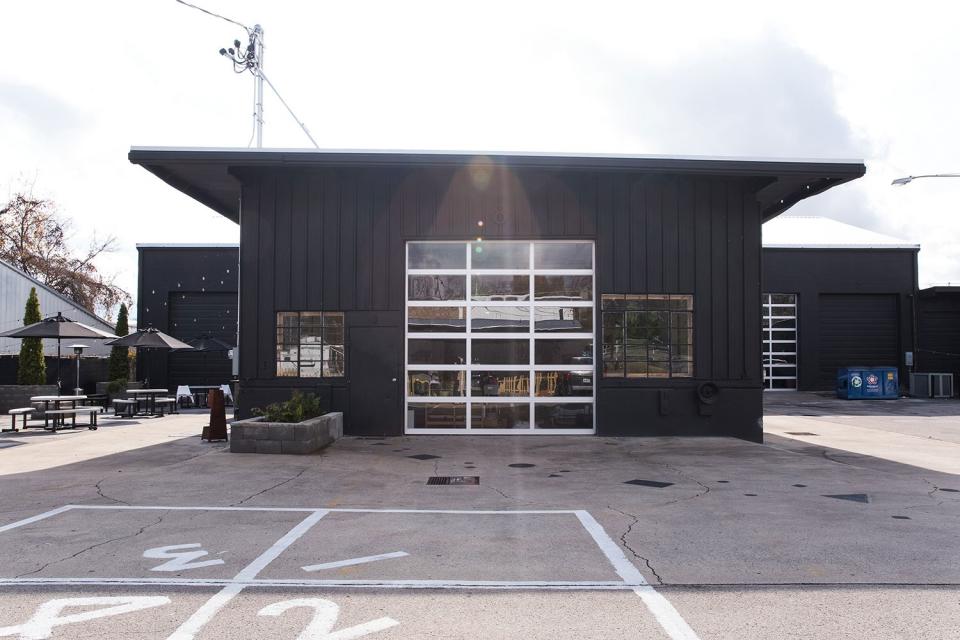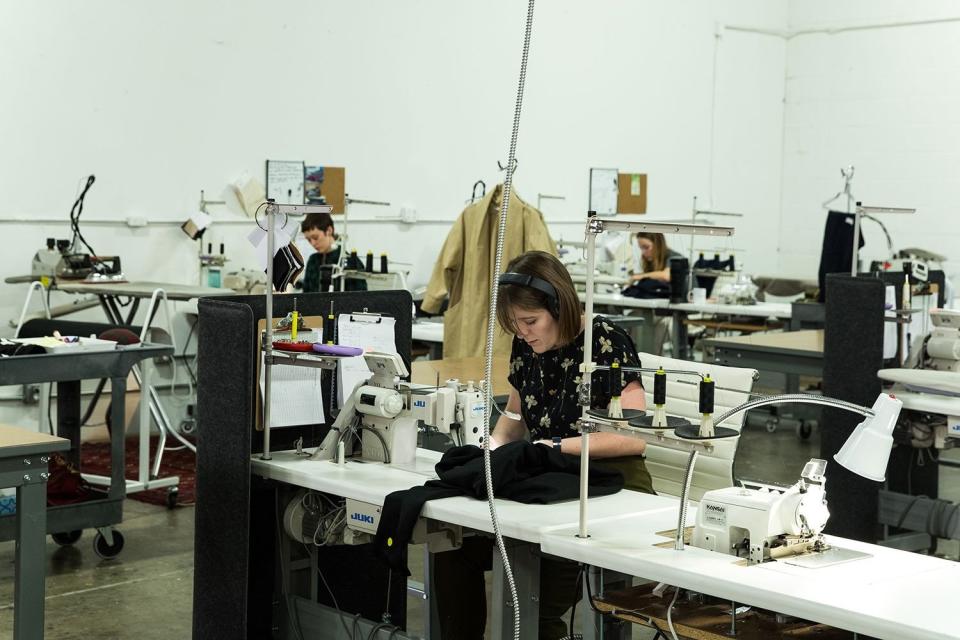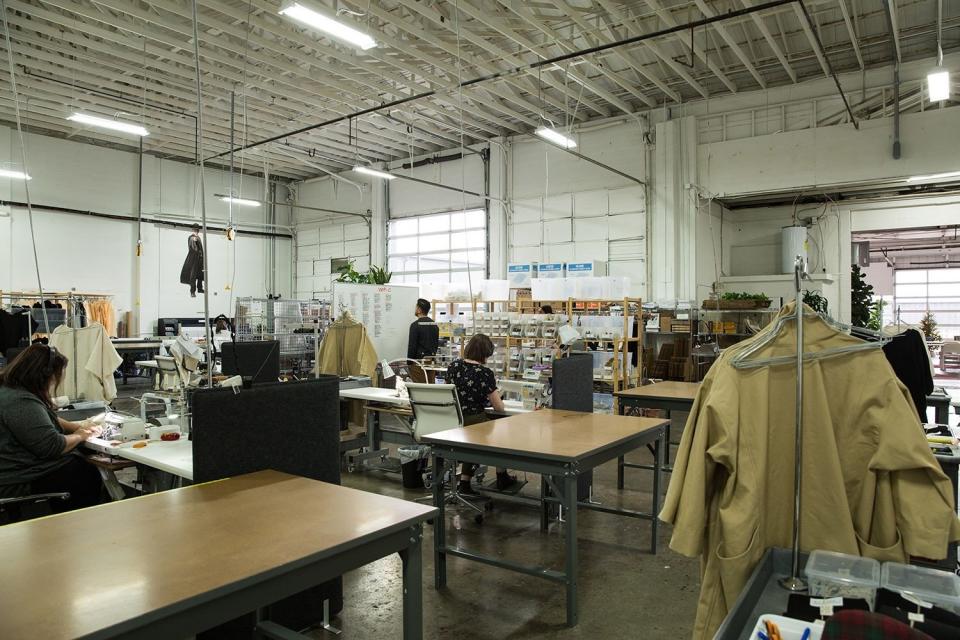Fashion Brand Elizabeth Suzann Has a Utopian Vision for Fashion’s Future
Elizabeth Suzann (ES) makes beautiful clothes. They’re the kind of well-cut pieces that look effortless: gauzy linen shirts in colors like terra-cotta and olive, cotton canvas pants inspired by a ’20s beach staple, dresses that swish rather than cling. Founder Liz Pape turned a hobby into a multimillion-dollar business and credits a pivotal day at a craft fair for convincing her there might be enough interest in her designs to make a livelihood. But her biggest success has nothing to do with clothes.
Half a century ago, 95% of clothes bought in the U.S. were made here. In 2015, that figure was down to 3%, already making ES’s Nashville factory/headquarters, which was founded in 2013 and now employs over 40 people, an anomaly. But many companies producing apparel in the U.S. rest on the consumer assumption that the increase in wages from overseas factories to domestic ones is matched with increased labor standards, even though that’s not always the case. “Some of the worst conditions I’ve seen are in domestic factories,” Edward Hertzman, a consultant and founder of Sourcing Journal, explained a few years ago.
Then there’s ES’s factory, where cosmetic efforts for a better working environment — plants, artist-commissioned murals, free cold brew on tap — are matched by concrete ones. “We try to integrate work into people’s lives so it doesn’t feel like this huge burden,” Pape says. Destiny DeStefano, who’s worked on the cutting team since November 2017, is most grateful for the flexible scheduling. “The freedom to balance work with the reality that life doesn’t always allow for a set schedule really relieves a lot of stress,” she says. Employees describe ES as “transparent,” “homey,” and a company that “truly cares about us.”
Elizabeth L. Cline, the author of Overdressed: The Shockingly High Cost of Cheap Fashion and The Conscious Closet: The Revolutionary Guide to Looking Good While Doing Good has watched sustainability in fashion move from a niche concern to a mainstream buzzword, particularly picking up steam in the past few years. Because sustainably produced clothes are often more expensive, Cline sees the conversation snag on cost. But that cost is often very narrowly defined. “We consistently overlook and ignore the extractive, exploitative heart of the fast fashion system,” she says. “Instead of arguing about what a dress should be priced, we should be fighting for everyone to get a fair wage.”
But the high cost of these items can also make sustainability seem out of reach or like an elitist concern. Maxine Bédat, the founder and director of the New Standard Institute, a nonprofit that brings scientific rigor to fashion’s sustainability and labor issues by offering resources for brands hoping to improve their environmental and social impact, raises a legitimate concern. “I get nervous about anything that connects sustainability with something expensive, particularly when those things are always associated with one another,” she says. “There is a middle ground price point that can incorporate the right environmental and social protections.”


ES is expensive — a silk crepe tunic is $195, durable linen trousers run $205 — but they engage in sustainable practices while prioritizing their employees, which is not something all brands with clothes sold at that price point do. “Things could look a lot different if money were our main motivator,” Pape says. Her husband, Chris Martucci, joined the company a year after the launch and serves as partner/chief operations officer. They could take bigger salaries if they paid employees less or offered fewer benefits, for example, but that’s not the kind of company they want to work at, let alone run. Instead, they’d rather try to create the workplace they want and then make sure their employees get those same benefits.
Only two staffers are part-time, and the full-timers are eligible to receive vision, dental, and health insurance through the company. Sixty-five percent of staffers are paid an hourly wage, which starts at $14 per hour with performance raises between 3 to 7%. (The minimum wage in Tennessee is $7.25 per hour.) In order to align with the #FightFor15 movement, they’ll be adjusting to a $15 per hour starting wage in the coming months and increasing the speed of performance-based raises. “There are folks who started with us on the selling team, the cutting team, or on the fulfillment team who are now leading teams of their own and really growing here,” Pape says, citing internal promotions as one of the company’s accomplishments she’s most proud of.


Mae Redha, who joined ES last winter as the people and culture director (ES’s answer to HR), is proud of the wellness-related benefits they offer, which extend well beyond fitness. “Not only do we currently offer free yoga and personal training once per week, but we also provide an Employee Assistance Program that gives each employee and their household five free and confidential counseling sessions with a third-party provider every year, self-guided online programs to improve health and emotional well-being, legal assistance, financial coaching, and work-life services,” she explains.
In December 2017, via a blog post on the company’s site, Pape wrote about their new holiday break policy. “[Last year,] during the busiest season of the year, some people on the team felt guilty taking extra time off to travel and visit family,” she wrote. “Others didn’t have any remaining Paid Time Off.…We wanted to find a way to collectively pause, reflect, and celebrate with our loved ones. We wanted to generate that feeling of summation, accomplishment, and fellowship that the end of a college semester brings.” So in addition to the PTO benefits already offered, they began implementing a paid 10-day break between Christmas Eve and New Year’s Day.
While the kind of benefits they offer do have some benefit for the bottom line — improving employee retention, for example — that’s not what’s driving Pape and Martucci. The way the clothes are made speaks to the couple’s commitments, Pape says. Instead of assembly-line production, which results in hours of rote sewing or cutting the same piece over and over, an employee will spend the day making a number of different pieces. “There are a lot of things we could change to have an impact on our efficiency, but it’s not the kind of business we want to run,” Pape says. Cline brought up ES’s production too: “If you work in a garment factory and your job is to sew the neckline on a shirt a thousand times a day, that is mind-numbing, demoralizing work,” she says. But textile work doesn’t have to be like that. At ES, every garment is sewn start to finish by one person.

A number of brands with the aesthetic, ethical, and/or environmental principles ES shares have come under fire for a lack of size inclusivity. Many of these companies sell clothes that don’t fit the average American woman, who is a size 16 or 18. Even companies way bigger than ES have yet to succeed in this regard. For example, Everlane, founded on the model of “radical transparency,” has been criticized for limited sizing, urging their plus sized customers to “be patient” while they “take the time to do it right”. Teen Vogue reached out to Everlane for further comment. Last year, Everlane drew ire after using plus-size models to sell underwear that only went up to size XL. For women, they now offer one T-shirt style and one sweater in XXL; mid-rise, and high-rise skinny jeans up to size 35; and a few pairs of pants up to size 20. In 2018, after much criticism and demand for more inclusive sizing, Reformation released an extended sizing capsule collection with Ali Tate Cutler, offering sizes 0 to 22 and XS to 3XL. “We’re super sorry we didn’t do it sooner,” the brand said in a press release, according to Elle. Earlier this year, Reformation released a permanent extended sizing collection.
It’s expensive to offer an extensive range of sizes, particularly if you want to do it right, Pape says. She’s had the experience of walking into stores selling beautiful, minimal clothing only to find nothing in her own size. “So much of what I see is only made for tall and thin women,” she says. “I wanted to get out of that quickly as we could.” By 2014, they offered XS through XL, 00 to size 16. In 2018, after protracted fit testing and pattern development, ES began offering their pieces in a range from XXS to 4XL, from 000 to size 28.

The response was immediate. “I can’t tell you what it means to be able to feel good about a clothes purchase in terms of ethics, quality, AND fit! When most clothing experiences are negative, painful, and depressing, your company is a ray of light!” a customer wrote on Pape’s Instagram post announcing the more substantial sizing options. “Being plus size and also being socially conscious about clothing at the same time seems almost impossible…But now you have made it possible,” another added. ES shot new campaign and product imagery to reflect the full range of sizing available. In addition to a thorough online sizing guide, they encourage customers to reach out with their own body measurements if they’re unsure about fit. (Last year, ES sent 22,977 customer support emails.)
It’s easier to extend sizing when you’re using a made-to-order model, which ES does, because it doesn’t require producing large amounts of every item in every size; instead, they only produce items once they’ve been purchased. So far, they’ve converted over three quarters of their offerings to extended sizing and will carry every style in the full range by the end of the year. Their made-to-order model also means a longer wait time. You can’t order an ES dress for a wedding next weekend as the current lead time is 2 to 3 weeks. They also cap orders weekly once they hit the number employees can produce without increasing wait time.

As clothing prices have dropped, American closets have become increasingly overstuffed. Forbes reports that back in 1930, an American woman could expect to own nine outfits...total. Today, according to the American Apparel and Footwear Association, the average American buys 65 pieces of clothing a year, and the Council for Textile Recycling estimates that they send about 70 pounds of textiles, mostly clothing, to landfills annually. In 2014, we bought 60% more pieces of clothing than we did in 2000 and kept each garment for half as long. ES has emerged amid a rising concern over the environmental cost of clothing, a growing interest in sustainably made clothing, and an emphasis on buying fewer, higher-quality items.
For some buyers, an ES dress means forgoing 10 fast fashion ones. But there will always be those for whom a $265 dress will never be feasible, no matter how much they’re committed to principles of ethical consumption. I was curious to hear if and how the Elizabeth Suzann team have a game plan for making their brand feel more inclusive to those who might not be able to afford it outright. Pape quickly rattled off a number of things they’re considering. There’s already a market for secondhand ES pieces and they’re thinking of bringing that in house to make it more accessible. ES is exploring the idea of a loyalty program, kind of like an airline mileage program, which would allow buyers to either use accumulated points themselves or donate them to a communal pot for others. They may also release sewing patterns of a few of their most popular pieces so that people could sew their own.

While answering my questions, Pape was quick to point out ES is far from perfect. There are a number of things they need to improve on. ES has tried to increase diversity with various recruiting strategies, which haven’t been as successful as they’d like; “simply visually speaking, we are a very white team,” Pape says. So they've recently hired a diversity, equity, and inclusion consultant to audit the organization and make recommendations for improvement.
Currently, they only use natural fibers, but they’re trying to move to sourcers with better environmental and labor practices. “We have a lot of work to do to vet the labor practices of our suppliers, and we are doing that one material at a time,” she says, offering wool as an example. For over a year, they’ve been working to develop a stronger wool supply chain, settling on a domestically raised, climate-beneficial wool that’s then dyed, spun, and woven by a family-owned business. They’ve visited the facilities for every step of the process to better assess conditions.
ES’s online fabric guide explains how long it takes for each fabric to biodegrade, but Bédat pointed out that the way we currently dispose of clothing forestalls that process. “It is often said that natural fibers are better because they’re biodegradable and plastics are not, but what that ignores is that in a landfill, is an anaerobic environment in which nothing biodegrades,” she says. In an interview with Mother Jones, Ramani Narayan, a professor of chemical and biochemical engineering at Michigan State University, echoed the same sentiment. Overall, when it comes to natural fabrics, Bédat says it’s important to “preference those materials combined with holding onto them longer,” or getting more wears out of the clothing we buy. Consuming less may be at odds with market goals, but that’s crucial.

When it comes to making the fashion industry more sustainable, “the biggest challenge right now is that what’s sustainable is being defined by the brands,” Bédat says. That means they can be alternately general and specific when it suits by positioning themselves as green without further clarification or proffering one small sustainable choice as indicative of the whole brand. Pape tries not to use labels like sustainable or ethical because they’re vague; instead, ES prefers to clearly outline what they do and allow consumers to judge for themselves.
Fashion’s sustainability problem isn’t something we can shop our way out of; it requires collective action, better regulation, and a more rigorous, comprehensive framework for sustainability. The way many brands have defined sustainability often leaves out labor, with the people along the supply chain treated as disposable. “The reason why industries are more willing to glom on to sustainability is that sustainability on some level is about making your supply chain more efficient,” Cline, the author of Overdressed: The Shockingly High Cost of Cheap Fashion and The Conscious Closet: The Revolutionary Guide to Looking Good While Doing Good explains. “You could actually end up making more money by going into factories and reducing the amount of energy and water used to manufacture something. With labor, brands have lost sight of investing in people. They just see labor costs as something that they have to constantly drive down.”

Meanwhile, at ES, Pape and her husband aren’t satisfied with the extensive benefits they currently offer to employees. In the future, they’d like to figure out a way to have an on-site day care and more resources for both staffers and Nashville’s larger artistic community.
While there are lots of companies invested in solid labor practices and/or sustainability operating at various sizes, Cline told me a number of small, privately owned companies like ES that started around the same time have since gone out of business. It’s difficult to run a company like ES. But she sees ES’s role as “setting the standard” for good practices, which can have ramifications beyond their employees and consumers. “There was a lot of doubt in the beginning,” Pape says, of ES’s early days. “A lot of people completely disagree with our methods and would tell us, ‘That’s fine for now, but one day you're going to have to actually act like a real business.’” But they are a real business, and they’re really doing well. Part of that success lies in showing a working alternative to business as usual.
Alex Ronan is a freelance journalist spending her time in New York City and Berlin.
Originally Appeared on Teen Vogue

